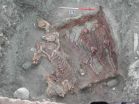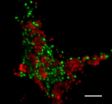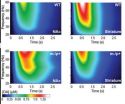(Press-News.org) A group of researchers led by the Universitat Autònoma de Barcelona (UAB) has discovered the first scientific evidence of genetic blending between Europeans and Asians in the remains of ancient Scythian warriors living over 2,000 years ago in the Altai region of Mongolia. Contrary to what was believed until now, the results published in PLoS ONE indicate that this blending was not due to an eastward migration of Europeans, but to a demographic expansion of local Central Asian populations, thanks to the technological improvements the Scythian culture brought with them.
The Altai is a mountain range in Central Asia occupying territories of Russia and Kazakhstan to the west and of Mongolia and China to the east. Historically, the Central Asian steppes have been a corridor for Asian and European populations, resulting in the region's large diversity in population today. In ancient times however the Altai Mountains, located in the middle of the steppes, represented an important barrier for the coexistence and mixture of the populations living on each side. And so they lived isolated during millennia: Europeans on the western side and Asians on the eastern side.
The research conducted by researchers from the UAB, the Institut Català de Paleontologia Miquel Crusafont and the Institute of Evolutionary Biology (UPF-CSIC) sheds new light on when and how this Eurasian genetic blending took place.
At the UAB palaeogenetic laboratory researchers analysed mitochondrial DNA (inherited from the mother, it allows us to trace our ancestors) extracted from the bones and teeth of 19 skeletons from the Bronze Age (7th to 10th century BCE) and from the Iron Age (2nd to 7th century BCE) from the Mongolian Altai Mountains. The remains were extracted from the tombs discovered seven years ago, in which the skeletons of Scythian warriors were discovered and which represented the first scientific evidence of this culture in East Asia.
The results obtained demonstrate that the population from the Iron Age, corresponding to the time when the Scythian culture resided in the Altai Mountains, had a perfect blend (50%) of European and Asian mitochondrial DNA lineages or sequences. The discovery is relevant, taking into account that previous populations showed no signs of lineage mixture: the DNA analysed in the tombs located in Russia and Kazakhstan belong to European lineages, whereas DNA from the eastern part, in Mongolia, contain Asian lineages.
"The results provide exceptionally valuable information about how and when the population diversity found today in Central Asian steppes appeared. They point to the possibility that this occurred in Altai over 2,000 years ago between the local population on both sides of the mountain range, coinciding with the expansion of the Scythian culture, which came from the west", explains Assumpció Malgosa, professor of Biological Anthropology at UAB and coordinator of the research.
Studies conducted until now on ancient DNA samples from the Altai region already indicated that the Scythians were the first large population to be a mixture between Europeans and Asians. However, the only populations to be studied were those on the western part of the Eurasian steppes, suggesting that this mixture was due to population migrations from Europe to the east.
The current research is the first to offer scientific evidence of this population mixture on the eastern side of the Altai and indicates that the contact between European and Asian lineages occurred before the Iron Age when populations were present on both sides of the mountain. The study suggests that the Asian population adopted the Scythian culture, technologically and socially more advanced, and this made them improve demographically by favouring their expansion and contact with Europeans.
The idea poses a new hypothesis on the origin of today's population diversity in Central Asia and allows for a better understanding of the demographic processes which took place.
Frozen Scythian Warrior Tombs
From 2005 to 2007, UAB researchers worked jointly with French and Mongolian researchers in a European project to excavate Scythian tombs in Mongolia's Altai Mountains. In the three excavation campaigns carried out over twenty tombs were excavated. Many of them were frozen and contained mummified human remains of warriors buried with their possessions and horses. This was the first time Scythian warrior tombs had been discovered in Mongolia, since all other tombs previously found had been located on the western side of Altai.
The Scythians were an Indo-European people dedicated to nomadic pasturing and horse breeding. They crossed the Eurasian steppes from the Caspian Sea until reaching the Altai Mountains during the 2nd and 7th century BCE. The Scythians are known most of all thanks to ancient texts written by the Greek historian Herodotus.
INFORMATION:
Mongolia and the Altai Mountains: Origins of genetic blending between Europeans and Asians
2012-11-12
ELSE PRESS RELEASES FROM THIS DATE:
Elsevier launches new journal: 'Health Care: The Journal of Delivery Science and Innovation'
2012-11-12
New York, November 12, 2012 – Elsevier, a world-leading provider of scientific, technical and medical information products and services, is pleased to announce the launch of Health Care: The Journal of Delivery Science and Innovation.
Health Care provides a vehicle for communicating important advances in the study of cutting edge research on innovation in health care delivery, including improvements in systems, processes, management, payment, and applied information technology. The United States health care system is undergoing unprecedented reform; Health Care builds ...
Call for global monitoring of infectious diseases in dogs and cats
2012-11-12
Most emerging infectious diseases of humans come from animals. International health agencies monitor these diseases, but they do so only for humans and livestock, not for companion dogs and cats. A new study recommends a global system is needed to monitor infectious diseases of companion dogs and cats.
The study, led by Michael Day, Professor of Veterinary Pathology in the School of Veterinary Sciences at the University of Bristol and published online in Emerging Infectious Diseases, lists key infectious diseases that may be transmitted between dogs and cats and man ...
At least 6 major earthquakes on the Alhama de Murcia fault in the last 300,000 years
2012-11-12
Enjoying Spanish participation, an international group of researchers have analysed the most recent history of the Alhama de Murcia fault. They discovered that it has experienced six major earthquakes above 7 on the Richter scale. According to the scientists, this provides "convincing evidence" that the maximum earthquake magnitudes in the area are higher than originally thought.
Since 2001, researchers from the Universities of Barcelona, Leon, Complutense de Madrid (UCM), Coimbra (Portugal), Aahus (Denmark) and the National Autonomous University of Mexico have been working ...
Scientists unravel the mystery of marine methane oxidation
2012-11-12
This press release is available in German.
Microbiologists and geochemists from the Max Planck Institute for Marine Microbiology, along with their colleagues from Vienna and Mainz, show that marine methane oxidation coupled to sulfate respiration can be performed by a single microorganism, a member of the ancient kingdom of the Archaea, and does not need to be carried out in collaboration with a bacterium, as previously thought. They published their discovery as an article in the renowned scientific journal Nature.
Vast amounts of methane are stored under the ocean ...
Obesity epidemic threatens health of all social groups equally
2012-11-12
It is often assumed that those on low incomes and with low levels of education are overly represented in the major increase in obesity of recent decades.
A new thesis from the Lund University School of Economics and Management, Sweden, shows that obesity is increasing across all social groups and that we need to look at factors other than socioeconomic status to understand and solve one of the major public health concerns of the Western world.
Åsa Ljungvall, a researcher in economics at the Lund University School of Economics and Management, has studied the increase ...
Smart drug improves survival in older patients with acute myeloid leukemia
2012-11-12
A new study has found Acute Myeloid Leukaemia (AML) patients given a new type of 'smart drug' in addition to chemotherapy treatment are 22 per cent less likely to relapse and around 13 per cent less likely to die from their disease. The results are from a major phase III Cancer Research UK-funded trial led by Cardiff University.
Of the 1,115 patients who took part in the trial, 68 per cent relapsed on the new treatment within three years, compared with 76 per cent of those who had the standard treatment. And 25 per cent were still alive after three years, compared with ...
Place in the sun carries risks for outdoor workers
2012-11-12
Those individuals who work outdoors with resultant sun exposure are at increased risk for non-melanoma skin cancers, such as squamous cell carcinoma and basal cell carcinoma. Manigé Fartasch shows that the connection between occupational UV exposure and squamous cell carcinoma is now well-established in her review article in issue 43 of Deutsches Ärzteblatt International (Dtsch Arztebl Int 2012; 109(43): 715−20).
The results are less clear for basal cell carcinoma, another form of non-melanoma skin cancer. Skin cancers caused by UV light have not yet been considered ...
The consequences of late preterm birth
2012-11-12
Delivery at any time before the 39th week of gestation increases the risk of postnatal problems and mortality. A team of authors headed by Christian F. Poets has analyzed mortality and morbidity data from epidemiological studies of infants born between two and six weeks preterm, comparing them with infants born at full term. They present their findings in issue 43 of Deutsches Ärzteblatt International (Dtsch Arztebl Int 2012; 109(43): 721−6).
As a rule, elective Cesarean sections are performed somewhat before full term, in order to prevent spontaneous delivery. However, ...
Ultrasound gel and infections: Researchers propose guidelines to reduce risk
2012-11-12
CHICAGO (November 12, 2012) – In the December issue of Infection Control and Hospital Epidemiology, the journal of the Society for Healthcare Epidemiology of America, guidelines have been proposed by epidemiologists from Beaumont Health System to reduce the risk of infection from contaminated gels. The recommendations are based on the authors' own experiences with an outbreak traced to contaminated ultrasound transmission gel.
In December 2011, researchers uncovered an unusual cluster of Pseudomonas aeruginosa in a cardiovascular surgery intensive care unit during routine ...
Study justifies L-DOPA therapy for Angelman syndrome
2012-11-12
CHAPEL HILL, N.C. – Last year a clinical trial of L-DOPA -- a mainstay of Parkinson's disease therapy -- was launched for Angelman syndrome, a rare intellectual disorder that shares similar motor symptoms such as tremors and difficulty with balance. The clinical trial is based on a 10-year-old case report showing benefit with the drug, but few studies since have explored the neurological justification for using L-DOPA to treat parkinsonian features in Angelman syndrome.
New research from the University of North Carolina School of Medicine, conducted in animal models ...




